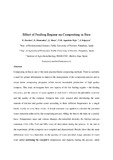Mostrar el registro sencillo del ítem
Effect of feeding regime on composting in bins
| dc.creator | Storino, Francesco | es_ES |
| dc.creator | Menéndez Villanueva, Sergio | es_ES |
| dc.creator | Muro Erreguerena, Julio | es_ES |
| dc.creator | Aparicio Tejo, Pedro María | es_ES |
| dc.creator | Irigoyen Iriarte, Ignacio | es_ES |
| dc.date.accessioned | 2017-05-02T10:39:21Z | |
| dc.date.available | 2018-04-03T23:00:12Z | |
| dc.date.issued | 2017 | |
| dc.identifier.issn | 1065-657X (Print) | |
| dc.identifier.issn | 2326-2397 (Electronic) | |
| dc.identifier.uri | https://hdl.handle.net/2454/24149 | |
| dc.description | This is an accepted manuscript of an article published by Taylor & Francis in Compost Science & Utilization on 2017, available online: http://dx.doi.org/10.1080/1065657X.2016.1202794 | en |
| dc.description.abstract | Composting in bins is one of the most practical home composting methods. There is currently a need for greater information to improve the management of the composting process and to create home composting programs, which ensure sustainable production of high quality compost. This study investigates how two aspects of the bin feeding regime—the feeding frequency and the amount of waste applied at each feed—influence the process's evolution and the quality of the compost. Compost bins were assayed after introducing the same amount of kitchen and garden waste according to three different frequencies: in a single batch, weekly, or every 3 weeks. A fourth treatment was applied to calculate the potential waste reduction achieved by the composting process, filling the bins to the brim on a weekly basis. Temperature, mass, and volume changes; the microbial diversity (by Biolog); and gas emissions (CO2, CH4, N2O, and NH3) were all determined during the process. At the end of the experiment, all of the composts were weighed and characterized. Results show that the main differences were very dependent on the quantity of waste provided. Large amounts of waste were added increasing the compost's temperature and maturity during the process, while slightly affecting the salinity and phytotoxicity of the final compost but without any clear effects on microbial diversity and gas emission. Therefore, from a technical point of view, the shared use of compost bins among several households (community composting) is preferable to individual us | en |
| dc.format.mimetype | application/pdf | en |
| dc.language.iso | eng | en |
| dc.publisher | Taylor & Francis | en |
| dc.relation.ispartof | Compost Science and Utilization 2017, vol. 25, no. 2, 71-81 | en |
| dc.rights | © 2017 Taylor & Francis | en |
| dc.subject | Compostaje doméstico | es_ES |
| dc.subject | Compostaje comunitario | es_ES |
| dc.subject | Biorresiduos | es_ES |
| dc.subject | Home composting | en |
| dc.subject | Community composting | en |
| dc.subject | Biowaste | en |
| dc.subject | Prevención residuos | en |
| dc.subject | Waste prevention | en |
| dc.title | Effect of feeding regime on composting in bins | en |
| dc.type | Artículo / Artikulua | es |
| dc.type | info:eu-repo/semantics/article | en |
| dc.contributor.department | Ciencias del Medio Natural | es_ES |
| dc.contributor.department | Natura Ingurunearen Zientziak | eu |
| dc.contributor.department | Producción Agraria | es_ES |
| dc.contributor.department | Nekazaritza Ekoizpena | eu |
| dc.contributor.department | IdAB. Instituto de Agrobiotecnología / Agrobioteknologiako Institutua | es |
| dc.rights.accessRights | Acceso abierto / Sarbide irekia | es |
| dc.rights.accessRights | info:eu-repo/semantics/openAccess | en |
| dc.embargo.terms | 2018-04-03 | |
| dc.identifier.doi | 10.1080/1065657X.2016.1202794 | |
| dc.relation.publisherversion | https://dx.doi.org/10.1080/1065657X.2016.1202794 | |
| dc.type.version | Versión aceptada / Onetsi den bertsioa | es |
| dc.type.version | info:eu-repo/semantics/acceptedVersion | en |


